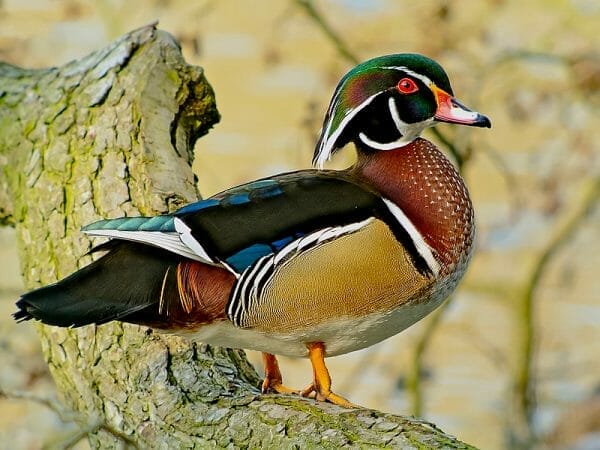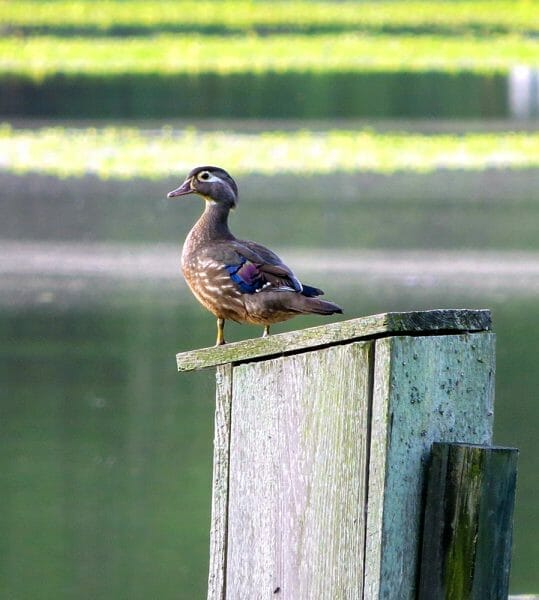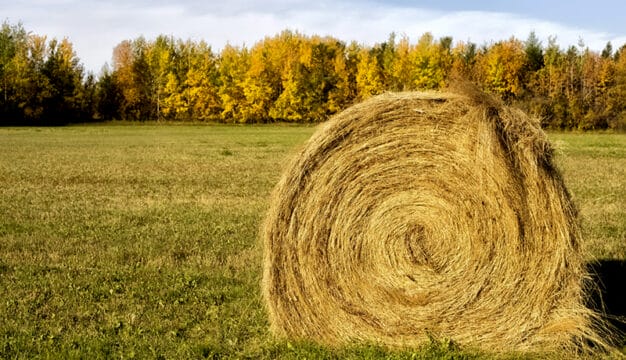Wood Duck
The wood duck (Aix sponsa) is a member of the Anseriformes Order and the Anatidae Family. It is the only duck species that lives year-round in Alabama and nests throughout the state. Colloquially, wood ducks are sometimes referred to as “woodies,” “swamp ducks,” or “acorn ducks.” It is the most common duck found in Alabama and the second most harvested by hunters after the mallard (Anas platyrhynchos). The wood duck is also the only duck species in North America to have both migratory and non-migratory populations. In Alabama and other southern states, migration is either very short or non-existent.
 Male Wood Duck
Its scientific name comes from the Greek word for “waterbird” (aiks) and the Latin word for “betrothed” (sponsa), which refers to the male bird’s elaborate plumage being likened to wedding clothing. Male wood ducks, or drakes, have the most colorful plumage among the duck species of North America. With a striking iridescent green and purple head boasting a large sweeping crest, distinct red irises, a burgundy chest, and bronze, wavy lined sides, the males are unmistakable. In contrast, the female, or hen, is less colorful but is still considered to be one of the most attractive female ducks. They possess pronounced teardrop-shaped white eye-rings, a white chin, and grayish-brown feathers. Their heads are slightly crested and are glossed green when observed closely. Juvenile wood ducks closely resemble the hens, except that their bellies are streaked and mottled brown instead of white. The average adult wood duck is about 17 to 20 inches (43 to 51 centimeters) tip to tail.
Male Wood Duck
Its scientific name comes from the Greek word for “waterbird” (aiks) and the Latin word for “betrothed” (sponsa), which refers to the male bird’s elaborate plumage being likened to wedding clothing. Male wood ducks, or drakes, have the most colorful plumage among the duck species of North America. With a striking iridescent green and purple head boasting a large sweeping crest, distinct red irises, a burgundy chest, and bronze, wavy lined sides, the males are unmistakable. In contrast, the female, or hen, is less colorful but is still considered to be one of the most attractive female ducks. They possess pronounced teardrop-shaped white eye-rings, a white chin, and grayish-brown feathers. Their heads are slightly crested and are glossed green when observed closely. Juvenile wood ducks closely resemble the hens, except that their bellies are streaked and mottled brown instead of white. The average adult wood duck is about 17 to 20 inches (43 to 51 centimeters) tip to tail.
Wood ducks create pair bonds anywhere from late October through late February. After the pair bonds have been formed, the nesting period begins in early February. Wood ducks utilize a variety of wooded and shrubby wetland habitats throughout the year. During the breeding season, they prefer to nest in areas that have 50 to 75 percent coverage of either water-tolerant trees, shrubs, or dense vegetation that grows in the water near the bank. After the breeding season, wood ducks in Alabama have been found to prefer forested wetlands. Wood ducks usually return to the same breeding areas every year.
 Juvenile Wood Duck
Wood ducks nest almost exclusively in cavities in trees, particularly those created by pileated woodpeckers (Dryocopus pileatus). The ducks prefer cavities with openings with a diameter of approximately 3 inches (~7.5 centimeters), interior space within the cavity with a diameter of 5 or more inches (~12.5 centimeters), and a depth of approximately 24 inches (~61 centimeters). Conservationists also have installed numerous artificial next boxes to boost populations and create more available nesting locations. Hens incubate their eggs for 30 days. Clutches are large, usually consisting of 12 to 14 eggs. The young spend almost no time in the nest, fledging within a day of hatching. Ducklings are able to fly at approximately 8 to 10 weeks of age, at which point the hen will molt her breeding plumage and is finished caring for the young. Drakes molt their feathers while the hens incubate the eggs, seeking secluded areas with cover because they are flightless during this time. The drakes do not return to help care for the young and instead flock together with other males.
Juvenile Wood Duck
Wood ducks nest almost exclusively in cavities in trees, particularly those created by pileated woodpeckers (Dryocopus pileatus). The ducks prefer cavities with openings with a diameter of approximately 3 inches (~7.5 centimeters), interior space within the cavity with a diameter of 5 or more inches (~12.5 centimeters), and a depth of approximately 24 inches (~61 centimeters). Conservationists also have installed numerous artificial next boxes to boost populations and create more available nesting locations. Hens incubate their eggs for 30 days. Clutches are large, usually consisting of 12 to 14 eggs. The young spend almost no time in the nest, fledging within a day of hatching. Ducklings are able to fly at approximately 8 to 10 weeks of age, at which point the hen will molt her breeding plumage and is finished caring for the young. Drakes molt their feathers while the hens incubate the eggs, seeking secluded areas with cover because they are flightless during this time. The drakes do not return to help care for the young and instead flock together with other males.
Wood ducks are “dabbling” or “puddle” ducks, meaning they float on the surface of shallow water and tip to retrieve food, rarely submerging. They consume leafy vegetation, seeds, and fruits throughout most of the year. Hens and ducklings also seek out rich sources of protein such as insects, spiders, and small crustaceans (such as crayfish) during the breeding season. Ducklings consume these invertebrates almost exclusively during their first few weeks after fledging. According to the Alabama Cooperative Extension Service, the populations in Alabama largely rely on acorns during the winter months. Although wood ducks will sometimes fly to agricultural fields to feed, they prefer to feed in shallow water.
 Female Wood Duck
The wood duck was driven to the brink of extinction in the early twentieth century owing largely to streamside timber cutting, beaver removal, and unregulated hunting. Beavers are important creators of wetland habitat; by damning streams they create flooded areas that are critical for many species, such as other mammals, amphibians, fish, and birds. In addition to the snowy egret and the sandhill crane, the wood duck was one of the threatened species that prompted the passage of the Migratory Bird Treaty Act of 1918, after a landmark Supreme Court case, Missouri v. Holland, that asserted the federal government’s right to regulate hunting. The act included a broad range of prohibitions against hunting, possessing, selling, and buying protected birds and parts. Enacted by the United States and Canada, it protected the wood duck from being harvested legally until 1941, when authorities determined that the populations had recovered suitably. This recovery still continues as populations of wood ducks expand with the reintroduction and expansion of beaver populations, wetland conservation, and the use of nest boxes. Some conservationists consider the recovery of the wood duck as one the most successful instances of wildlife conservation in the United States. Wildlife experts estimate that there are approximately three million wood ducks in the United States, Canada, Cuba, and northeast Mexico.
Female Wood Duck
The wood duck was driven to the brink of extinction in the early twentieth century owing largely to streamside timber cutting, beaver removal, and unregulated hunting. Beavers are important creators of wetland habitat; by damning streams they create flooded areas that are critical for many species, such as other mammals, amphibians, fish, and birds. In addition to the snowy egret and the sandhill crane, the wood duck was one of the threatened species that prompted the passage of the Migratory Bird Treaty Act of 1918, after a landmark Supreme Court case, Missouri v. Holland, that asserted the federal government’s right to regulate hunting. The act included a broad range of prohibitions against hunting, possessing, selling, and buying protected birds and parts. Enacted by the United States and Canada, it protected the wood duck from being harvested legally until 1941, when authorities determined that the populations had recovered suitably. This recovery still continues as populations of wood ducks expand with the reintroduction and expansion of beaver populations, wetland conservation, and the use of nest boxes. Some conservationists consider the recovery of the wood duck as one the most successful instances of wildlife conservation in the United States. Wildlife experts estimate that there are approximately three million wood ducks in the United States, Canada, Cuba, and northeast Mexico.
Further Reading
- Baldassarre, Guy A. Ducks, Geese, and Swans of North America. Vol. 1. Washington, D.C.: Wildlife Management Institute, 2014.
- Bellrose, F. C., and D. J. Holm. Ecology and Management of the Wood Duck. Mechanicsburg, Penn.: Stackpole Books, 1994.



